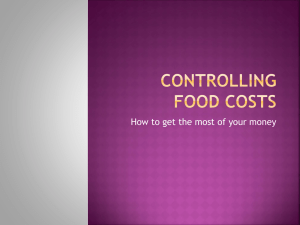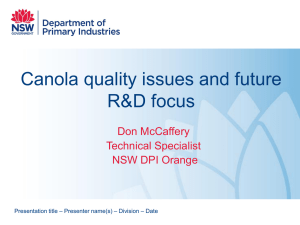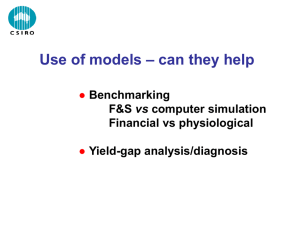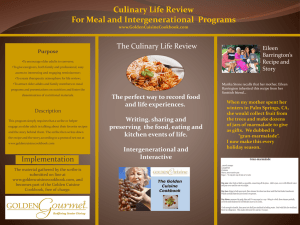Kitchen Calculations
advertisement
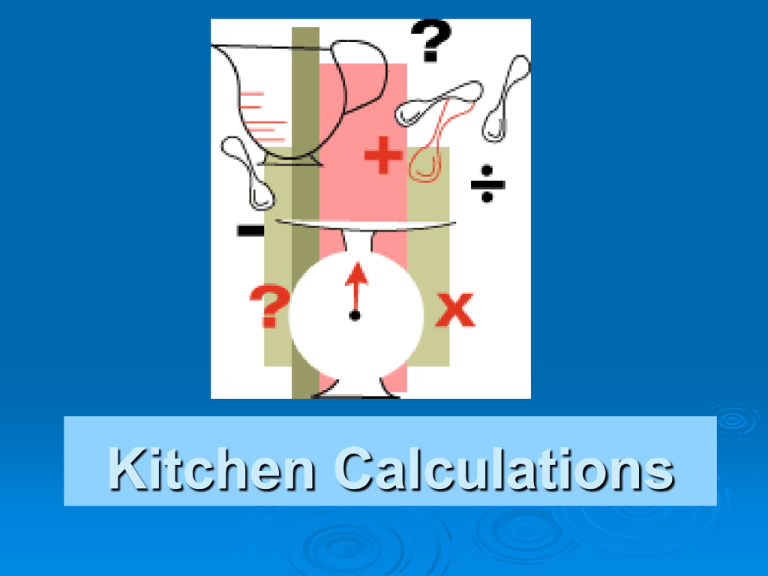
Kitchen Calculations As Purchased The product as it is purchased. The item has an as purchased, or AP, unit of measure. The items has an as purchased, or AP, price, and price per unit of measure. AP Example: The AP unit of measure is pounds. The AP weight is 20 lbs. The case of apples cost $60.00 $60.00 (cost for cs.) / 20 lbs = $3.00 ( cost per lb) Determined AP costs: The cost per lb.= $3.00 The AP price = $60.00 The AP price per lb = $3.00 Edible Portion The amount of product available to serve the guest after cleaning, trimming, and cooking the product. The item will have an edible portion, or EP, unit of measure. The item will have an edible portion, or EP, price per unit of measure. The apples will have an: EP weight less than (<) the AP weight (due to the trimming and shrinkage during cooking.) The apples will have an: EP price per lb. Greater than (>) the AP price per lb. (Due to trimming and shrinkage during cooking.) Yield % The majority of food purchased is trimmed and/or cooked. This process causes the EP weight to vary from the AP weight. A food item can shrink, resulting in loss of weight. The difference b/w AP weight (volume) EP Weight (volume) =yield %. Yield % Formulas Yield % Example of Case of Pears: A case of pears with an AP weight of 20 lbs. Trimming causes a “loss’ of AP weight. The apples are cooked for a Tart Tatin on the stove. Cooking causes a “loss of weight. The apples are weighed after cooking. It now weighs 10 lbs. This is the EP weight. To Determine a products yield: Yield % = EP weight (or volume) AP weight (or volume) Example yield % for pears: = Yield % = EP weight AP weight The yield % for pears = Yield % = 10 lbs = .50 = 50% 20 lbs The yield % is also = to 1/2, or 0.50 What does Yield % mean? 50% means 1/2, .5 or 50% of the pears are lost in the trimming and cooking process. are only 10 lbs of product available (edible portion) to serve to your guests There from a 20 lb AP weight. Does Yield % impact Food Purchasing? Direct impact on the quantity of product purchased. The amount of product purchased is not = to the amount of product available to serve to the guest. AP weight NOT = EP Weight Yield % have a impact on Food Cost? SIGNIFICANT IMPACT on food cost. in amount of food purchased impacts the cost of food served to the guest. To BUY: 40 lbs pears AP @ $3.00/lb It COSTS the following: $3.00 (cost per lb) x 40 (lbs.) = $120.00 (cost for 40 lbs.) $120.00 (AP cost for 40 lbs) / 20 (EP yield) = $6.00 per lb. Yield % Food Cost Formula EP = AP price per unit Yield % The actual cost per pound to serve the guest is $6.00 per lb. EP price = $3.00 (price/lb AP) 50%, or 0.5 The yield % is used to determine the actual cost to serve the food to guest. These calculations are critical to the success of a foodservice operation. EP = $6.00 per lb FOOD COST % Refers to the % of the menu price that the cost represents. Example: Cost …. $2.50/ Menu price …. $10.00 .25 Why? 2.50 is 25% of 10 The 25% of food % means that every time the $10.00 menu item is sold $2.50 of the $10.00 pays for the costs of the food $7.50 is available to pay for other costs of doing business & the profit. The 9 Steps to calculate Recipe Cost Step 1: Refer to blank standardized recipe cost form. Step 2: Transfer ingredients, quantities, and recipe yield from a standardized recipe form. Step 3: Transfer the AP unit of measure and AP price per unit from the purveyors invoice(s). Step 4: Look up each ingredient’s: Average yield % Unit of measure conversion if AP unit is different. Unit of measure conversion for item AP count, bunch, etc. 9 Steps Continued Step 5: Perform the calculations to 4 decimal places to first determine the EP cost per unit. Step 6: Then determine the EP cost for the total # of units in the recipe. Step 7: Add each ingredient cost to arrive at a recipe cost. Step 8: Multiply the recipe cost by 102%, or 1.02, to add in the cost of miscellaneous ingredients. Step 9: Divide the total recipe cost by the number of portions it yields to determine the actual cost per portion. (the total cost can be rounded here or after the per portion cost.) Blueberry Essence Bowl Easy to cost b/c the ingred. have a 100% yield. The AP cost per unit is = to the EP cost per unit. The amount of the item used in the recipe is multiplied by the AP cost and the items total recipe cost is the product. After all ingredient items’ cost are determined, they are added together to find the recipes’ total cost. The cost per portion is determined by dividing the total recipe cost by the # of portions it serves. Example Total cost to make 6 qts. of blueberry essence is $11.3388, rounded to $11.34. Soup can be served in a cup or bowl. The cup holds 4 oz & the bowl holds 8 oz. Total Edible product/ Portion size = Number of portions: 6 qts = 6 (qts) x 32 (oz per qt) = 192 oz 192 oz./ 4 oz (per cup) = 48 cups or 192 oz / 8 oz (per bowl) = 24 bowls. Calculating a recipe cost: Yield % & seasonings Seasoning can be a miscellaneous cost: Formula: 1. Recipe cost x 1.02% or 1.02 = Total recipe cost. 2. Total recipe cost /# portions = Cost per portion If an cake cost total = $19.29. The total recipe cost, with the 2% for miscellaneous ingredients, is as follows: $19.29 x 1.02 = $19.6758, rounded to $19.68
